
The Uniting Church, Albert Street
[Photograph by Trevor Bunning (October 2007)]

The Uniting Church, Albert Street
[Photograph by Trevor Bunning (October 2007)]
Historical and Technical Documentation by Geoffrey Cox
© OHTA 2011, 2014 (last updated October 2014)
Queensland Methodists were under the supervision of the New South Wales Conference until 1893, and a minister was first appointed to 'Moreton Bay' in 1847.1 With the arrival of Rev. William Moore in that year, services were conducted initially in a small building in Queen Street. The first Methodist (Wesleyan) chapel in Albert Street was opened in March 1849, on the site between Burnett Lane and Adelaide Street. It was replaced in January 1856 by a more substantial brick church in Gothic style on the same site.2
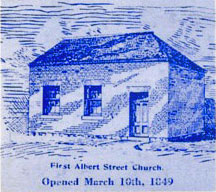
The first Albert Street Wesleyan Church
[Drawing from present Albert Street Uniting Church]
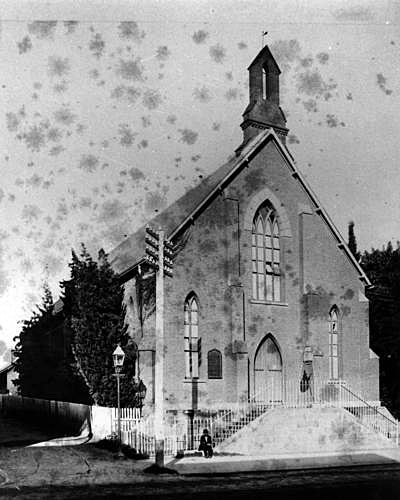
The second Wesleyan Church, Albert Street, Brisbane, c.1883
[Photograph: John Oxley Library, State Library of Queensland]
The present church, on the corner of Albert and Ann Streets, was opened on 8 November 1889.3 It was designed in Victorian Gothic style with a corner spire by the Brisbane architect, G.H.M. Addison, of Oakden, Addison & Kemp. The construction is of brick with Oamaru sandstone dressings, and the interior features a fine timber-vaulted ceiling with an upper gallery supported by delicate cast-iron columns.4 Extensive restoration work on the church was undertaken in 1974.5
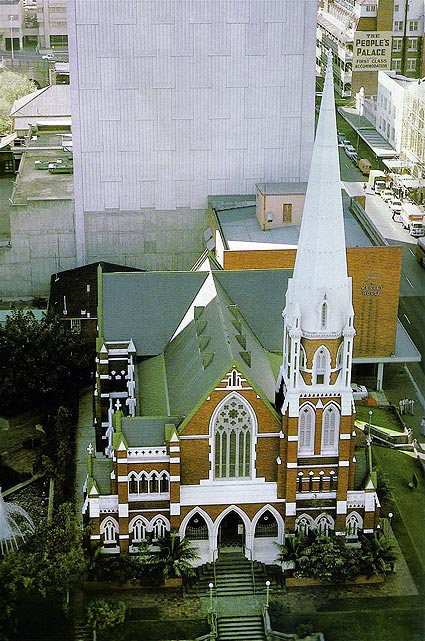
The present Albert Street church, opened in November 1889
[Photograph by Trevor Bunning (October 2007)]
First Organ (former church, cnr Albert Street and Burnett Lane).
The organ in the former Albert Street Wesleyan Church was built by James Cole of Manchester, and installed in the church in 1878. It is now located in St Thomas' Anglican Church, North Ipswich.
Present Organ.
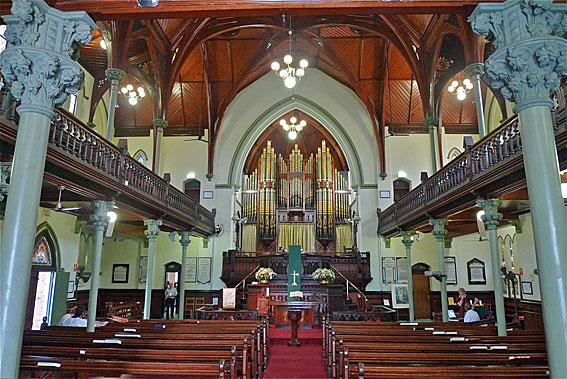
The present organ at the Albert Street Uniting Church
[Photograph by Trevor Bunning (November 2011)]
The organ in the present (1889) church was built by George Benson of Manchester, and was completed at Benson's organ works by 22 July 1889, when a recital was given on it by Mr Irvine Dearnaley.6 The specification was originally as follows:
| GREAT Double open diap Open diapason Viole de gambe St. diap & clarabella Harmonic flute Principal Fifteenth Mixture Trumpet SWELL Lieblich bourdon Open diapason Hohl flote Salicional Voix célestes Gemshorn Harmonic piccolo Mixture Cornopean Oboe CHOIR (in Swell Box) Dulciana Lieblich gedact Lieblich flote Clarionet PEDAL Open diapason Bourdon Violoncello COUPLERS Swell to great Swell to choir Swell to pedals Great to pedals Choir to pedals |
16 8 8 8 4 4 2 2 ranks 8 16 8 8 8 8 4 2 3 ranks 8 8 8 8 4 8 16 16 8 |
[gvd bass] [gvd bass] |
[Compass: 56/30]
4 composition pedals to Great and Pedal
3 composition pedals to Swell
Double pedal to act on great to pedals
Swell tremulant
Balanced swell pedal
Mechanical action, with pneumatic action to pedals.7
It has been reported in some sources that the organ was installed in the church by Thomas Christmas in 1890,8 although later Whitehouse Brothers records state that it was installed by Mr B.B. Whitehouse. A newspaper report of the opening of the church in November 1889 confirms that the organ was installed by B.B. Whitehouse, who was then working as 'head tuner' for W.H. Paling & Co.9 Only a portion of the instrument, however, was operational at the time of the opening:
. . . . The work of erecting the new organ has been placed in the hands of Messrs. Paling and Co., of Brisbane. Under the superintendence of Mr. Woodhouse [sic.] the organ has been making good progress towards completion. The shortness of the time rendered it impossible to get more than a small portion of it ready for use in time for the opening of the church. Only the swell organ and the pedal organ have been placed in position, and it is by these only that an estimate can be made of the quality of the instrument. Tested yesterday it gave promise of being a very valuable addition to the organs of Brisbane. Before being shipped to the colony it was tried at Manchester by Mr. Irvine Derneally [sic.], and was pronounced to be an excellent instrument. The English papers referred to it in terms of praise. When completed there can be little doubt that the organ will give every satisfaction. It was built by Mr. Geo. Benson, of Manchester, and the total cost has been about £1000. It is enclosed in a handsome case designed by Messrs. Oakden, Addison, and Kemp, and specially manufactured in England. The front pipes are tastefully coloured and gilded, and give a very imposing appearance to the instrument. The organ has three manual and a pedal clavier. In all there are thirty-one stops [sic.] and five couplers, which are divided as follows: Grand organ, nine stops, including grand double open diapason in metal; swell organ, ten stops, from, 16ft.; choir organ, four stops; the pedal organ consists of grand open diapason, 16ft.; Bourdon, 16ft.; and violoncello, 8ft. It may be stated that it is expected that the instrument will be finished in a fortnight or three weeks. Arrangements have been made for using it in a performance of the "Messiah" on the 27th instant.10
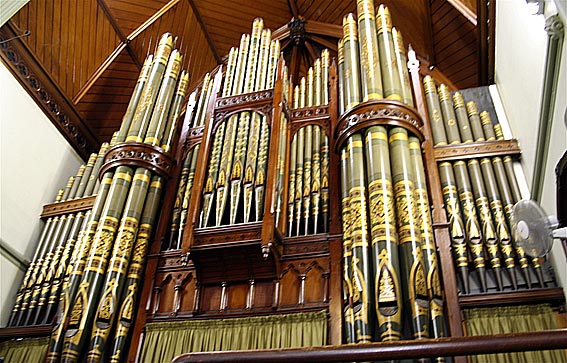
Casework of the organ, designed by the church architects,
Oakden, Addison and Kemp,
and manufactured by George Benson of Manchester
[Photograph by Trevor Bunning (October 2007)]
The promised performance of Messiah took place on 27 November, with a large choir and orchestra, and Mr S.G. Benson presiding at the organ.11 Benson was at this time organist either of the Wesleyan Church, Fortitude Valley, or of St Paul's Presbyterian Church, Brisbane. It was not until May 1892 that he was appointed organist at Albert Street.12
The organ remained without major alteration for more than two decades after installation, although a hydraulic engine was added in 1891:
A new blowing apparatus has been erected for the organ at the Albert-street Wesleyan Church. It was used for the first time on Sunday, and worked very satisfactorily. Prior to that the bellows of the organ had been worked by hand, and its size rendered that method far from suitable. The apparatus which has been secured consists of auxiliary feeders and reservoirs worked by a small hydraulic engine. It is placed in a room underneath the organ, and may be operated on either in there or from the organ. On the engine being put in motion it fills a set of four bellows, which communicate by an oblong-shaped air flue with the ordinary bellows of the organ. Automatic action prevents either feeders or reservoir from becoming overcharged. The feeders - the lower bellows - insure a regular supply of air for the organ, and the vibration and unsteadiness noticeable where hand or other mechanical appliances are used are almost entirely obviated. The organist sitting at the manuals has complete control over the engine, and by means of a lever can turn it on or off at pleasure. The apparatus is the only one of its kind in the colony, and the organist, Mr. Lord, speaks very highly of it.13
The only other addition in the 1890s was a Vox Humana stop added to the Swell in May 1895 by Mr B.B. Whitehouse. It had been 'ordered from France through Mr Wiegand' [of Sydney].14 The Vox Humana stop underwent alterations in 1898 when the organ received 'special attention' from Messrs Whitehouse and Marlor.15
Organ recitals at the Albert Street church were a regular feature of Brisbane's musical life in the 1890s,16 and the Sydney City Organist, Auguste Wiegand, gave a series of three recitals there on Saturday 18, Monday 20 and Tuesday 21 May 1895.17
Significant work appears to have been carried out on the organ in the latter part of 1902, as it was described in December that year as being 'reopened' with a recital by Mr O. C. Hearne, the organist of the church:
ORGAN RECITAL.
In celebration of the reopening of the fine pipe organ that has always had so marked an effect on the devotional music of the Albert-street Methodist Church, an organ recital is announced for to-night, for which the organist, Mr. O. C. Hearne, with Mr. F. L. South, hon. secretary, has arranged what should prove a very enjoyable programme. . . . Mr. Hearne will play five organ soli, and in several of the lighter of these, considering the excellent order in which the organ now is, some really beautiful effects in the soft stops may be expected. No doubt a crowded church will greet an entertainment of which (as a class) there have been too few in Brisbane in the past.18
The following description of the organ, published in 1906, corroborates facts recorded elsewhere and provides a few additional details:
ALBERT-STREET CHURCH ORGAN
This fine-toned powerful church organ was specially built by Mr. George Benson, Manchester, in 1889, to the order of the Albert-street Church, and according to the specification of Mr. J. Lord, at that time organist for this church. The cost was about £900. It is a three-manual organ containing 27 speaking stops, with five couplers, arranged as follows:- Swell organ, 11 stops; great organ, 9 stops; choir organ, 4 stops; pedal organ, 3 stops; three composition [pedals] to swell organ, and four to great organ, with pedal coupler great to pedals. The organ is practically the same now as when built, with the exception that a vox humana has been added, whilst it was originally blown by hand power, but this was supplanted some 18 months after its erection by hydraulic power. The organist is Mr. A. H. Littler, and choirmaster Mr. W. H. Longbottom.19
This description is accompanied by a photograph of the organ showing the original attached console with the drawstops arranged in two long columns on each jamb:
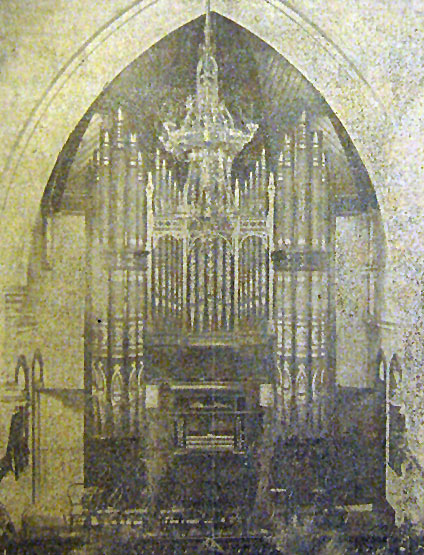
The George Benson organ of 1889
[Photograph: The Daily Mail (10 March 1906), p. 9.]
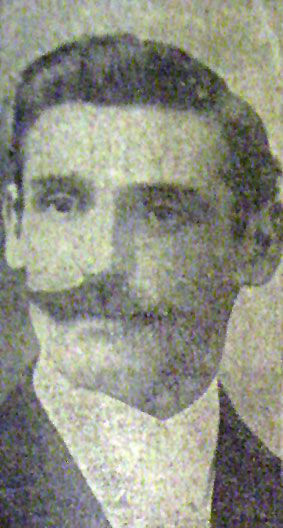
Mr A. H. Littler (Organist Albert-street Church)
[Photograph: The Daily Mail (10 March 1906), p. 9.]
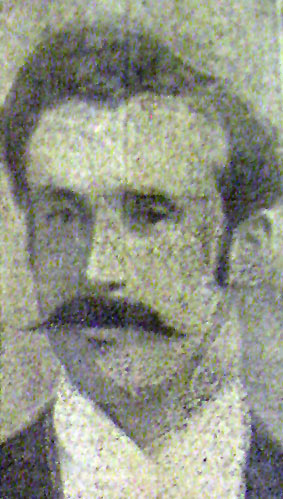
Mr W. H. Longbottom (Choirmaster Albert-street Church)
[Photograph: The Daily Mail (10 March 1906), p. 9.]
In 1911, the organ was rebuilt by B.B. Whitehouse & Co. under the supervision of the organist of the church, Mr A.H. Littler. The action was converted to tubular-pneumatic, the manual compass was increased from 56 notes to 58 notes, an electric blower was installed, and a new detached console was provided.20 The scheme was first announced in January 1911:
The trustees of the Albert-street Methodist Church have decided to have the organ thoroughly renovated and brought up to date. The mechanical and draw-stop action will be superseded by the latest up-to-date tubular pneumatic, and an entirely new console will be added, which will be brought forward to the front of the organ gallery, so that the organist will face the choir. At present the organ is blown by hydraulic power, but this is to be replaced by a kinetic electric blower. Several new couplers will be added to the organ, also a new 16ft. pedal trombone. The contract has been placed in the hands of Messrs B. B. Whitehouse & Co., Brisbane, and it is expected that the work will be completed about next September.21
The reconstructed organ was opened at Sunday services on 3 December 1911.22
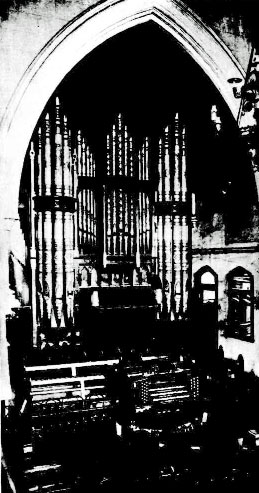
The new detached console by B.B. Whitehouse & Co in 1911
[Photograph: The Queenslander (9 December 1911), p. 5]
An overhaul and enlargement of the instrument by Whitehouse Bros was announced in March 1927, including the addition of five new stops, and the removal of the Pedal Trombone 16ft to a more favourable position:
The officials of the Albert-Street Methodist Church have decided on the recommendation of the church organist (Mr. A. H. Littler) upon certain improvements to the church organ, and the order for this work has been placed with Messrs. Whitehouse Bros., the well-known Brisbane organ builders. Nothing has been done concerning the organ since the time it was converted from the old tracker action to the present pneumatic action (10 years ago) until the present moment, and it was felt and also fully endorsed that what has now been decided upon should be accomplished; thorough cleaning, overhauling, and generally adjusting the respective parts necessary of the present existing organ. In addition several extra stops will be added, viz.: (a) great organ: large scale open diapason 8ft., claribel 8ft. (b) Solo organ (to be played from choir organ): Double trumpet, 16ft., tuba 8ft. (harmonic trebles, heavy wind pressure). (c) Pedal organ: Resultant bass 32ft., trombone 16ft., to be placed in more prominent position. The cost of the above work is estimated as just under £600. The whole alterations, together with additions, will be completed for the church anniversary in October next. 23
In the event, the organ was not officially re-opened until Sunday 26 February 1928, when the additions were announced also to include 'chimes,' reportedly the first to be fitted to an organ in Australia:
ORGAN CHIMES.
ALBERT-STREET CHURCH.
FIRST IN AUSTRALIA.
The organ of the Albert-street Methodist Church, is the first in Australia to be fitted with chimes, and these, in the hands of a master of the instrument, are capable of very fine musical effects.
Special services will be held in the church to-morrow to commemorate the re-opening of the improved and enlarged organ. Messrs. Whitehouse Bros., the organ builders, of Brisbane, have made a magnificent job of it, and music-lovers, especially those who are fond of organ music, are promised a rare treat on Sunday.
The morning and afternoon services will be conducted by the Rev. H. M. Wheller, and in the afternoon there will be a special choral service, under the baton of Mr. A. H. Littler, the church organist and choir master.
Following are the specifications of the alterations to the organ:- Great organ: Open diapason, 8ft. (large scale), 58 notes; claribel, 8ft. (bottom 12 from Lieblich Gedacht), 58 notes. Solo organ (to be played from choir organ): Double trumpet, 16ft. (from tuba), metal reed, 49 notes; tuba, 8ft., 58 notes, and chimes, 4ft., 20 notes. Pedal organ: Resultant bass, 32ft, from pedal open and great double.
The pedal reed has been removed to a new position, and the organ has been thoroughly cleaned and repaired. The new stops have been installed with a view to giving additional foundation tone to the instrument. The sounding tubes have been provided with silencers. The notes, therefore, sound only as long as the keys are pressed down.24
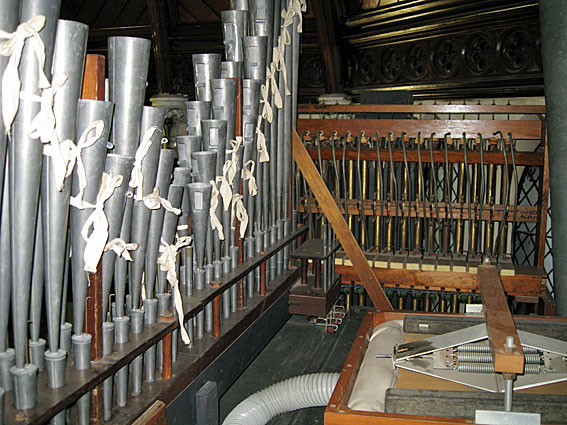
Tuba & Chimes added in 1928
[Photograph by Geoffrey Cox (July 2011)]
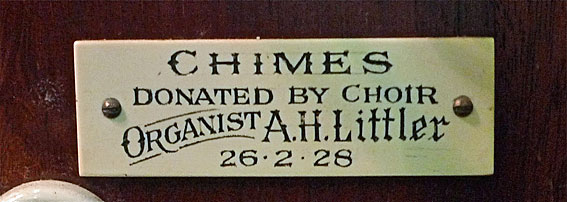
Plaque commemorating addition of Chimes in 1928
[Photograph by Trevor Bunning (November 2011)]
Following proposals initiated in 1948, the organ was again rebuilt by Whitehouse Bros, this time under the supervision of the organist of the church, Mr Archie Day. At this stage, the existing soundboards were replaced by slideless soundboards, the manual compass was extended to 61 notes, the action was converted to electro-pneumatic, and a new console (the third in succession) was provided. The pitch of the organ was lowered from C.540 to C.522 by moving all pipes up one note and supplying one new bottom note and two new top notes to each rank. Seven new stops were added, giving a total specification of 41 speaking stops and 12 couplers.25 The instrument was officially re-opened and dedicated on Sunday 5 August 1951.26
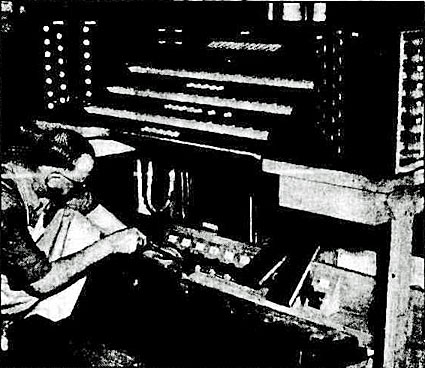
The new electric console being assembled at the Red Hill factory in 1950
[The Courier-Mail (1 February 1950), p. 7]

Plaque from the 1951 console
[Photograph by Geoffrey Cox (July 2011)]
The specification in 1951 was as follows:
| GREAT Double Open Diapason Open Diapason No. 1 Open Diapason No. 2 Open Diapason No. 3 Gamba Viol Da Gamba Clarabel Gedact Principal Flute Fifteenth Mixture Trumpet |
16 8 8 8 8 8 8 8 4 4 2 II 8 |
A |
[1889] [1951; described as 'Diapason Stentor' in letter of July 1948] [1928] [1889] [1951] [1889] [gvd bass] [1928] [gvd bass] [1889; described as 'Lieblich Gedact' in letter of July 1948] [1889] [1889] [1889] [1889] [1889] |
| SWELL Bourdon Violin Diapason Rohr Flute Salicional Vox Celeste Gemshorn Piccolo Mixture Cornopean Clarion Oboe Vox Humana |
16 8 8 8 8 4 2 III 8 4 8 8 |
B |
[1889] [1951] [1889] [1889] [gvd bass] [1889] [1889] [1889] [1889] [1889] [1951] [1889] [1895] |
| CHOIR (enclosed) Bourdon (Tenor C) Open Diapason Stop Diapason Dulciana Flute Double Trumpet (Tenor C) Tuba Orchestral Oboe Clarinet (Tenor C) Chimes |
16 8 8 8 4 16 8 8 8 |
C C |
[1951] [1889; originally on Swell] [1889] [1889] [1889; described as 'Lieblich Flute' in letter of July 1948] [1928/1951] [1928] [1951] [1889] [1928] |
| PEDAL Acoustic Bass Open Diapason Bourdon Echo Bass Cello Trombone |
32 16 16 16 8 16 |
A+D D B |
[1928] [1889] [1889] [1951] [1889] [1911] |
| COUPLERS Swell to Choir Swell to Great Swell to Great Sub Octave Swell to Great Super Octave Swell Sub Octave Swell Super Octave Choir to Great Choir to Great Sub Octave Choir to Great Super Octave Swell to Pedal Choir to Pedal Great to Pedal |
[1951] [1951] [1928] [1928] [1928] [1951] [1951] |
Swell tremulant
Choir tremulant
Great and Pedal Combination Coupled
Balanced swell pedal (mechanical)
Balanced choir pedal (mechanical)
5 thumb pistons to Swell Organ (adjustable)
5 thumb pistons to Great Organ (adjustable)
5 thumb pistons to Choir Organ (adjustable)
5 toe pistons to Pedal Organ (adjustable)
Great to Pedal reversible toe piston
Swell to Great reversible thumb piston
Full organ toe piston
General cancel piston.27
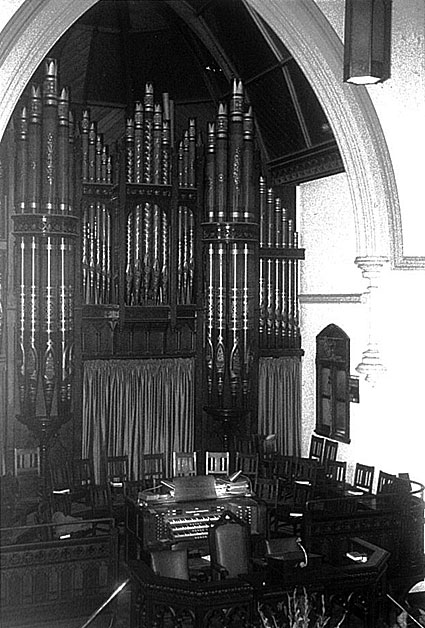
The organ in the mid-1970s,
including the 1951 Whitehouse console
[Photograph by Geoffrey Cox (1974)]
Whitehouse Bros was again engaged to rebuild the organ around 1977-78,28 but did not complete the contract. A replacement contract was signed with J.W. Walker & Sons (Australia) Pty Ltd late in 1982, and the organ was re-opened in February 1985.29 J.W. Walker & Sons provided yet another new console (the fourth in succession), and were able to use new pipework already obtained by Whitehouse Bros for the purpose. Two of the 1951 additions (Gt. Open Diapason No. 1 8ft and Ch. Orchestral Oboe 8ft) were moved in part to the Pedal Department, and three other 1951 stops (Ch. Bourdon 16ft [Ten C], Ch. Double Trumpet 16ft [Ten. C, borrowed from Tuba 8ft (1928)] and Ped. Echo Bourdon 16ft [borrowed from Sw. Bourdon (1889)] were deleted.30
Unfortunately two of the original 1889 Benson stops on the Great had already been removed for 'cleaning' in the late 1970s, and were never returned: These were the Gt. Open Diapason 8ft (which had become the Open Diapason No. 3 by 1951), and the Gt. Viole de gambe 8ft (labeled Viol Da Gamba by 1951).31
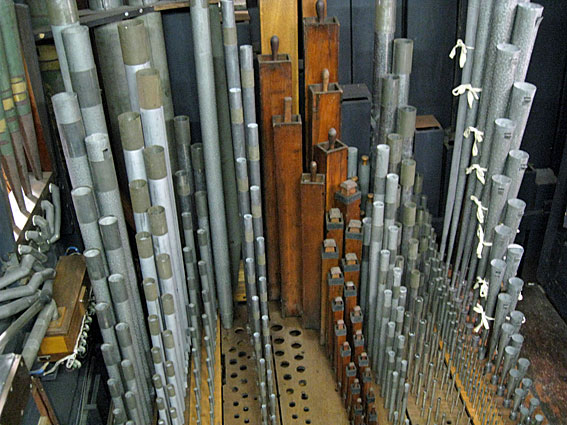
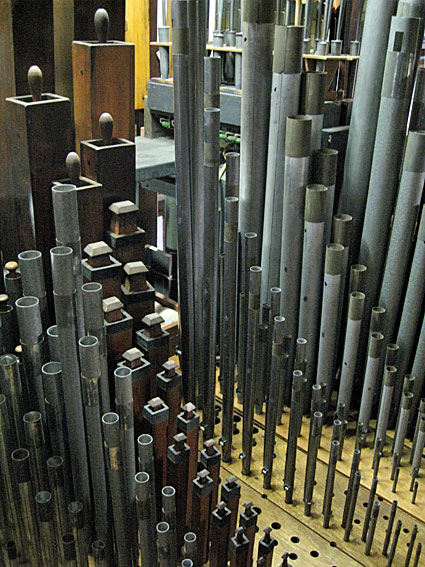
Pipework of the Great Organ on the 1951 soundboards,
showing space where two 1889 Benson ranks
(Open Diapason 8ft and Viole de gambe 8ft)
were removed in the late 1970s
[Photographs by Geoffrey Cox (July 2011)]
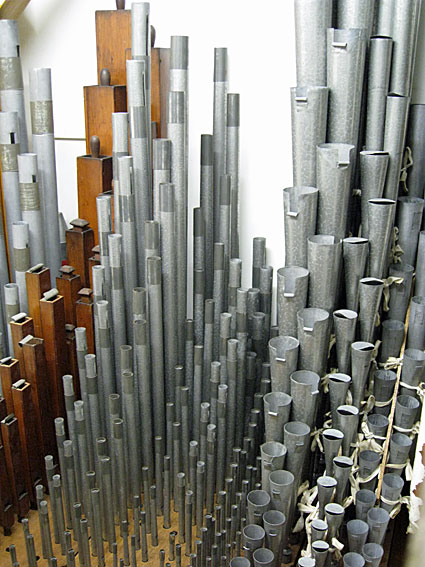
Pipework of the Swell Organ
[Photograph by Geoffrey Cox (July 2011)]
A Laukhuff electronic capture system, with sequencer, was installed in 2006 by W.J. Simon Pierce of Brisbane, enabling 12 general pistons to be added, with 60 levels of memory. The organ was fully refurbished by W.J. Simon Pierce in 2010.32
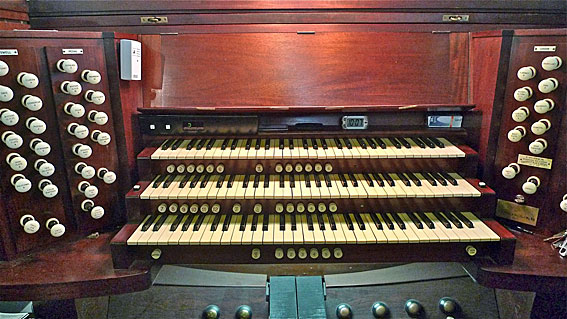
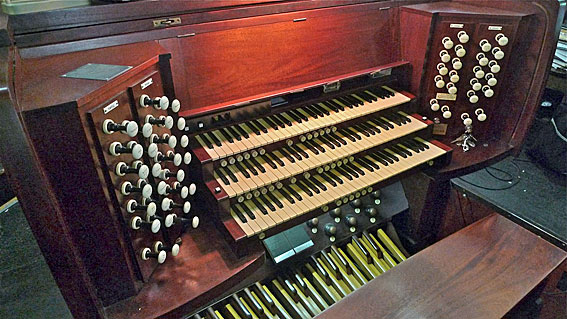
The J.W. Walker & Sons console of 1985
[Photographs by Trevor Bunning (November 2011)]
The current specification is given below, including dates of earlier ranks and other details [in square brackets] derived from earlier sources cited above:
| GREAT Double Diapason Open Diapason Stopped Diapason Gamba Principal Harmonic Flute Twelfth Fifteenth Mixture (19.22.26) Trumpet SWELL Violin Diapason Hohl Flute Salicional Voix Celestes Gemshorn Koppel Flute Piccolo Mixture (15.19.22) Cornopean Oboe Clarion CHOIR Open Diapason Wald Flute Principal Lieblich Flute Recorder Sesquialtera (12.17) Clarinet (Tenor C) Tuba Chimes PEDAL Acoustic Bass Open Diapason Bourdon Principal Cello Fifteenth [Mixture (12.15.19)] Trombone Schalmei COUPLERS Swell Sub Octave Swell Super Octave Swell to Great Choir to Great Swell to Choir Swell to Pedal Great to Pedal Choir to Pedal |
16 8 8 8 4 4 2-2/3 2 III 8 8 8 8 8 4 4 2 III 8 8 4 8 8 4 4 2 II 8 8 32 16 16 8 8 4 [III] 16 4 |
A A+B B C C |
[1889] [1928; Open Diapason No 2 in 1951] [1889; named 'Claribel' in 1982 proposal] [1951] [1889] [1889] [1985] [1889] [1889; one new rank 1985] [1889; revoiced 1985] [1951] [1889] [1889] [gvd bass] [1889] [1889] [1985] [1889] [1889; remodelled 1985] [1889; revoiced 1985] [1889; revoiced 1985] [1951; revoiced 1985] (enclosed) [1889; on Swell until 1951] [1889; named 'Stopped Diapason' in 1982 proposal] [1985] [1889] [1985] [1985] [1889; revoiced 1985] [1928; revoiced 1985] [1928] [1928] [1889] [1889] [1951 Great Open No 1] [1889] [1951 Great Open No 1] [prepared at console] [1911] [1951 Choir Orchestral Oboe 8] |
Swell tremulant
Choir tremulant
Great and Pedal Pistons Coupled
Balanced swell pedal (mechanical; electrical since 2010)
Balanced choir pedal (mechanical; electrical since 2010)
Sequencer [2006]
12 general pistons [2006]
6 thumb pistons to Swell Organ
6 thumb pistons to Great Organ
6 thumb pistons to Choir Organ
6 toe pistons to Pedal Organ.33

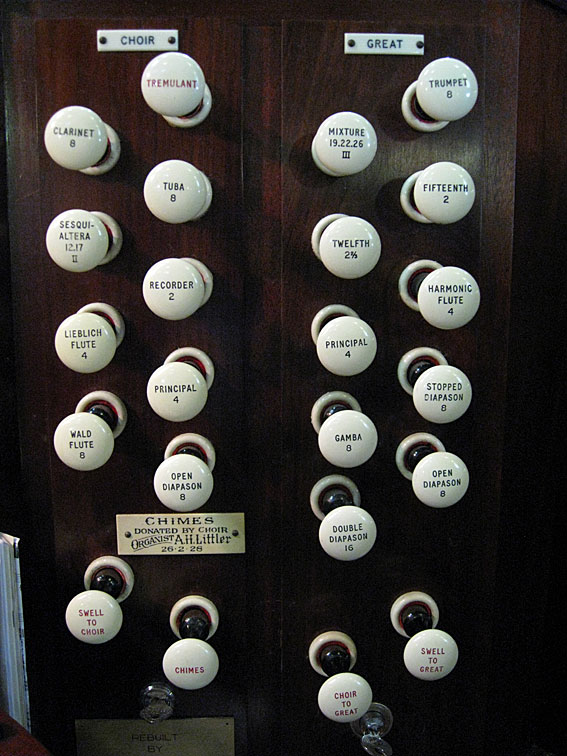
Left and Right Stop Jambs of the 1985 console
[Photographs by Geoffrey Cox (July 2011)]
Although the original integrity of the Benson organ has been compromised by successive rebuilding, the sound of the instrument remains tonally cohesive. The windchests and playing action have been altered, but most of the original pipework has been retained, still largely configured as intended within the tonal design. The original 1889 casework, designed by the architect of the church to match the other furniture and fittings, has also been retained.
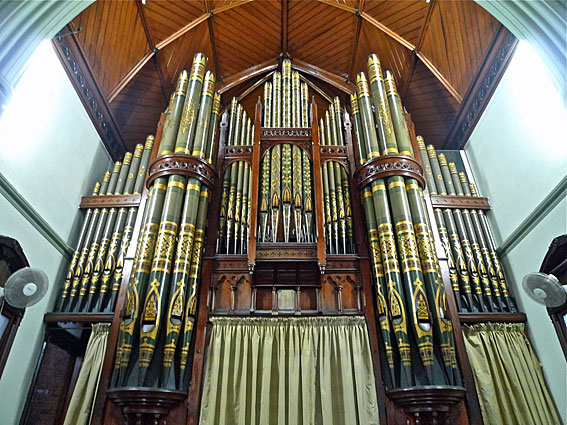
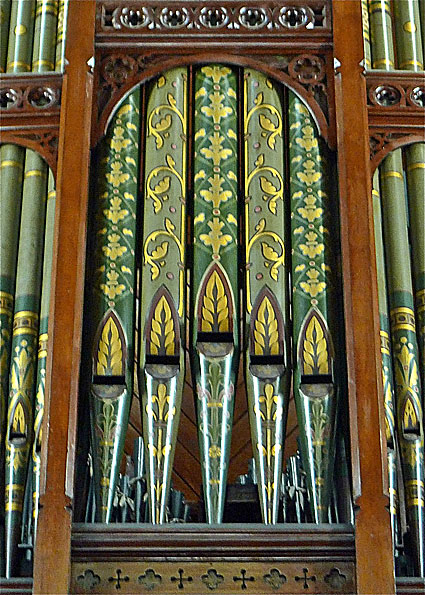
Original 1889 casework, designed by the church architect
[Photographs by Trevor Bunning (November 2011)]
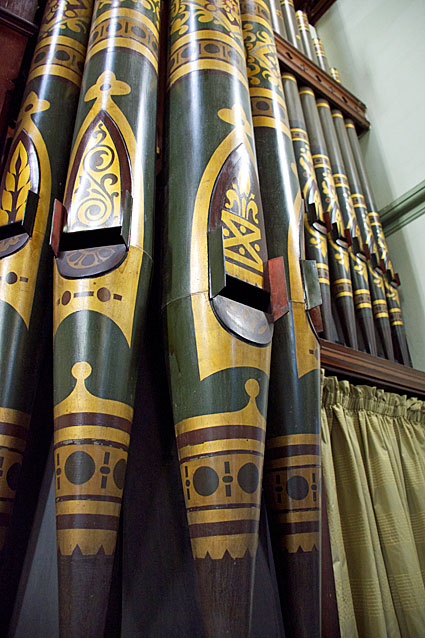
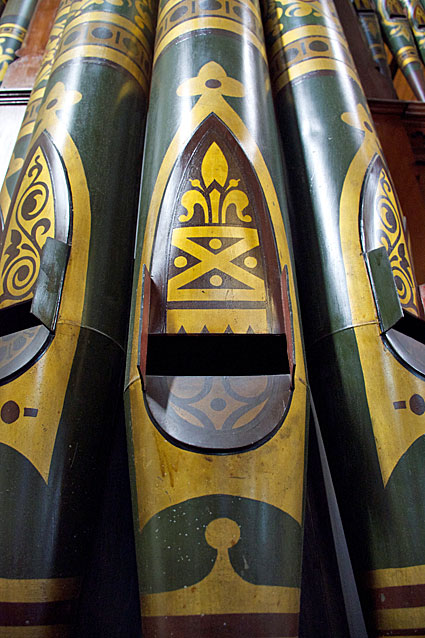
Details of stencilling on the façade pipes
[Photographs by Rodney Ford (September 2014)]
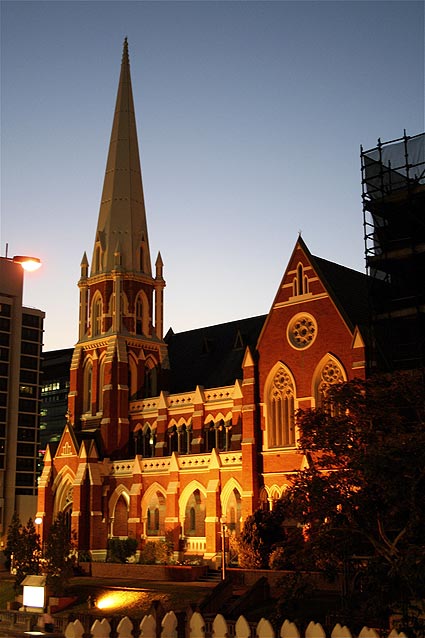
[Photograph by Trevor Bunning (October 2007)]
_______________________________________
1 R.S.C. Dingle, Annals of Achievement: A Review of Queensland Methodism, 1847-1947 (Brisbane: Queensland Book Depot, 1947), pp. 21, 32, 44, 166.
2 E.J.T. Barton, ed. Jubilee History of Queensland: a Record of Political, Industrial, and Social Development, from the Landing of the First Explorers to the Close of 1909 (Brisbane: H. J. Diddams, [c.1910]), p. 141.
3 Dingle, op. cit., pp. 84-85, 167; The Brisbane Courier (7 November 1889), p. 5; "Diary of Events" for 18 August 1888, 8 November 1889 and 10 November 1889 in Pugh's Queensland Almanac . . . for 1889 [and] for 1890.
4 The Brisbane Courier (8 November 1889), p. 6; Queensland Heritage Council, Queensland Heritage Register, location 600066; The Heritage of Australia: The Illustrated Register of the National Estate (South Melbourne: Macmillan, 1981), 4/12.
5 The Courier-Mail (26 November 1973).
6 The Musical Opinion & Music Trade Review, vol. 12, no. 143 (1 August 1889), p. 542.
7 The Musical Opinion, loc. cit. [Details in square brackets have been deduced from later sources.]
8 D.G. Vann, 'Organs in the Wesley Uniting Church, Brisbane,' OHTA News, vol. 2, no. 1 (January 1978), p. 26; Organ Society of Queensland Newsletter, vol. 15, no. 2 (October 1987), p. 6.
9 Geoffrey Cox, 'B.B. Whitehouse and the First Organ Built in Queensland,' OHTA News, vol. 35, no. 1 (January 2011), pp. 19-24.
10 The Brisbane Courier (8 November 1889), p. 6.
11 The Brisbane Courier (23 November 1889), p. 2.
12 The Brisbane Courier (9 May 1892), p. 4; The Brisbane Courier (28 May 1892), p. 5.
13 The Brisbane Courier (29 September 1891), p. 4.
14 The Brisbane Courier (4 March 1895, 6 May 1895, 13 May 1895, 14 May 1895, 2 December 1895, 9 March 1896 & 16 May 1898).
15 The Brisbane Courier (16 May 1898), p. 7.
16 see, for example, The Brisbane Courier (27 August 1894), p. 6; (3 Sept 1894), p. 5; (29 Oct 1894), p. 3.
17 The Brisbane Courier (18 May 1895), pp. 2 & 4.
18 The Brisbane Courier (13 December 1902), p. 5.
19 The Daily Mail (10 March 1906), p. 9.
20 Historical description of the organ in Whitehouse Bros records, c.1941, cited by G. Cox, c.1974.
21 The Brisbane Courier (13 January 1911), p. 5.
22 The Queenslander (9 December 1911), p. 27.
23 The Brisbane Courier (18 March 1927), p. 17; Whitehouse Bros Ledger (1922-1940), p. 330.
24 The Brisbane Courier (25 February 1928), p. 16; see also Advertisement on p. 3.
25 Letter and specification dated 5 July 1948 from Whitehouse Bros to the Trustees, Albert Street Methodist Church, cited in Whitehouse Bros records, c.1974; Whitehouse Bros Ledger (1940-1954), p. 300; The Courier-Mail (12 February 1951), p. 5.
26 The Courier-Mail (28 July 1951), p. 8; The Courier-Mail (4 August 1951), p. 10.
27 Specification noted by G. Cox, July 1974; Additional details from documentation cited above, and from specification accompanying letter dated 5 July 1948 from Whitehouse Bros to the Trustees, Albert Street Methodist Church, cited in Whitehouse Bros records, c.1974
28 Vann, op. cit., p. 28.
29 The Courier-Mail (25 February 1985), p. 10.
30 Details deduced from J.W. Walker & Sons proposal, supplied to G. Cox by David G. Vann, December 1982.
31 Personal communication to G. Cox from Simon Pierce, July 2011. The Great Open Diapason 8ft found its way to Somerville House (Brisbane High School for Girls), South Brisbane, around 1974-76, and the Great Viole de gambe 8ft to Corpus Christi Catholic Church, Nundah, around 1980.
32 Personal communication to G. Cox from Gregory Hartay-Szabo (organist), May 2011.
33 Specification noted by Geoffrey Cox, July 2011, with additional details [in square brackets] deduced from Whitehouse Bros records as cited above, and from the J.W. Walker & Sons rebuild proposal of 1982, op. cit.